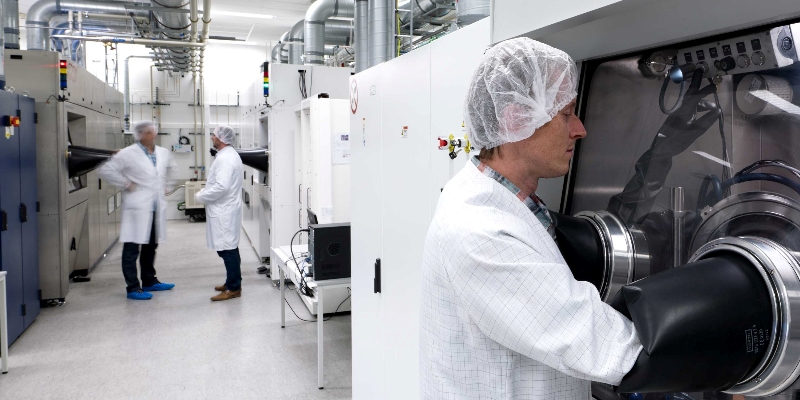We've updated publication list on our website, and reached a milestone! Feel curious to dive into more than 50 publications investigating Gallium Nitride power devices!
Our goals

The InRel-NPower project researches high voltage GaN and AlN transistors for application in power electronics, from growing the raw material to packaging and a demonstration of its potential in a final device. More in technical details, we aim for the development of:
Robust and reliable GaN-on-Si devices
AlGaN/GaN devices have great potential as the next generation power devices. Two main factors limiting their widespread adoption in the market are cost and reliability. The drawback of GaN-on-Si, where the GaN material is grown on top of a Si substrate, is that the hetero-structure requires advanced strain engineering techniques and the growth of multilayer stacks. This causes a large amount of crystal defects, which means that any power device for high current applications will have a drastic amount of defects in the device area. It is yet unknown how these defects will impact the long-term reliability of power devices, which is a major concern for wide-spread market adoption. InRel-NPower aims to identify the impact of strain-engineered buffer layer stacks on the leakage currents, link the results to device performance and reliability and optimize the process modules in order to obtain a better stability for the long-term.
AlGaN/GaN devices have great potential as the next generation power devices. Two main factors limiting their widespread adoption in the market are cost and reliability. The drawback of GaN-on-Si, where the GaN material is grown on top of a Si substrate, is that the hetero-structure requires advanced strain engineering techniques and the growth of multilayer stacks. This causes a large amount of crystal defects, which means that any power device for high current applications will have a drastic amount of defects in the device area. It is yet unknown how these defects will impact the long-term reliability of power devices, which is a major concern for wide-spread market adoption. InRel-NPower aims to identify the impact of strain-engineered buffer layer stacks on the leakage currents, link the results to device performance and reliability and optimize the process modules in order to obtain a better stability for the long-term.
Understanding the degradation mechanisms of Nitride-based devices
Power GaN-on-Si devices - as of today – still suffer from severe reliability issues when operating at their limits leading to a very short lifetime of just hours under system conditions. Both recoverable and permanent degradation may take place after few hours of operation at high temperature and bias levels. The reliability of GaN on Si devices has to be extensively improved. For this reason, understanding of the physical mechanisms responsible of device failure and their link to material properties are essential steps on the pathway to enable GaN power device to be disruptive. Benchmarking of GaN-on-Si vs. GaN-on-AlN and AlN-on-AlN devices will provide this insight by the InRel-NPower project.
Power GaN-on-Si devices - as of today – still suffer from severe reliability issues when operating at their limits leading to a very short lifetime of just hours under system conditions. Both recoverable and permanent degradation may take place after few hours of operation at high temperature and bias levels. The reliability of GaN on Si devices has to be extensively improved. For this reason, understanding of the physical mechanisms responsible of device failure and their link to material properties are essential steps on the pathway to enable GaN power device to be disruptive. Benchmarking of GaN-on-Si vs. GaN-on-AlN and AlN-on-AlN devices will provide this insight by the InRel-NPower project.
AlN-based devices for very high performance and reliability
Aluminum nitride (AlN) is the first choice as a wide band gap material because it has the highest bandgap of all common materials. This results in an advantageous set of properties for power semiconductor devices: excellent electrical insulation, high thermal conductivity, high flexural strength, stability at high temperatures and the highest ever reported breakdown field. Nonetheless, the application of AlN substrates for electronic devices is still in its infancy, mainly due to the limited availability of AlN bulk substrates. So, for these reasons the InRel-NPower project will explore the AlN-based lateral power devices.
Aluminum nitride (AlN) is the first choice as a wide band gap material because it has the highest bandgap of all common materials. This results in an advantageous set of properties for power semiconductor devices: excellent electrical insulation, high thermal conductivity, high flexural strength, stability at high temperatures and the highest ever reported breakdown field. Nonetheless, the application of AlN substrates for electronic devices is still in its infancy, mainly due to the limited availability of AlN bulk substrates. So, for these reasons the InRel-NPower project will explore the AlN-based lateral power devices.
Advancing the low-inductance packaging for power devices
The main goal is the implementation of innovative planar technologies, concerning on one hand the interconnection creating highly compact, flexible and scalable 3D multilayer technologies and on the other hand compact industrial inverter modules. To benefit from the fast switching which makes GaN devices superior, a system has to be specifically designed for fast switching, including the development of the topology as well as the assembly and formation of the interconnects. The InRel-NPower project will advance the packaging, aiming for a novel high-integrated packaging technique that includes embedded active and passive components and sensors for highly integrated intelligent power modules.
The main goal is the implementation of innovative planar technologies, concerning on one hand the interconnection creating highly compact, flexible and scalable 3D multilayer technologies and on the other hand compact industrial inverter modules. To benefit from the fast switching which makes GaN devices superior, a system has to be specifically designed for fast switching, including the development of the topology as well as the assembly and formation of the interconnects. The InRel-NPower project will advance the packaging, aiming for a novel high-integrated packaging technique that includes embedded active and passive components and sensors for highly integrated intelligent power modules.
Highly efficient systems with GaN devices
Within the project two demonstrators will be fabricated to exploit the potential of the developed GaN devices and packages at system level. Siemens in collaboration with Bosch targets the development of an inverter for motor drives. Benefit of these two demonstrates compared to today's standard modules will be an increased power density, higher reliability, high efficiency, smaller dimensions and improved overload capability. CE+T will develop a demonstrator which will be a set of several 2kW non-isolated DC/AC converters, aiming an efficiency above 98%.
Within the project two demonstrators will be fabricated to exploit the potential of the developed GaN devices and packages at system level. Siemens in collaboration with Bosch targets the development of an inverter for motor drives. Benefit of these two demonstrates compared to today's standard modules will be an increased power density, higher reliability, high efficiency, smaller dimensions and improved overload capability. CE+T will develop a demonstrator which will be a set of several 2kW non-isolated DC/AC converters, aiming an efficiency above 98%.


